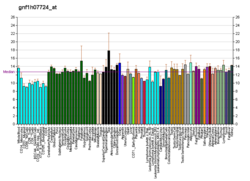| LGI2 | |||||||||||||||||||||||||||||||||||||||||||||||||||
|---|---|---|---|---|---|---|---|---|---|---|---|---|---|---|---|---|---|---|---|---|---|---|---|---|---|---|---|---|---|---|---|---|---|---|---|---|---|---|---|---|---|---|---|---|---|---|---|---|---|---|---|
| Identifiers | |||||||||||||||||||||||||||||||||||||||||||||||||||
| Aliases | LGI2, LGIL2, leucine-rich repeat LGI family member 2, leucine rich repeat LGI family member 2 | ||||||||||||||||||||||||||||||||||||||||||||||||||
| External IDs | OMIM: 608301; MGI: 2180196; HomoloGene: 10048; GeneCards: LGI2; OMA:LGI2 - orthologs | ||||||||||||||||||||||||||||||||||||||||||||||||||
| |||||||||||||||||||||||||||||||||||||||||||||||||||
| |||||||||||||||||||||||||||||||||||||||||||||||||||
| |||||||||||||||||||||||||||||||||||||||||||||||||||
| |||||||||||||||||||||||||||||||||||||||||||||||||||
| Wikidata | |||||||||||||||||||||||||||||||||||||||||||||||||||
| |||||||||||||||||||||||||||||||||||||||||||||||||||
Leucine-rich repeat LGI family member 2 is a protein that in humans is encoded by the LGI2 gene.
References
- ^ GRCh38: Ensembl release 89: ENSG00000153012 – Ensembl, May 2017
- ^ GRCm38: Ensembl release 89: ENSMUSG00000039252 – Ensembl, May 2017
- "Human PubMed Reference:". National Center for Biotechnology Information, U.S. National Library of Medicine.
- "Mouse PubMed Reference:". National Center for Biotechnology Information, U.S. National Library of Medicine.
- Gu W, Wevers A, Schroder H, Grzeschik KH, Derst C, Brodtkorb E, de Vos R, Steinlein OK (May 2002). "The LGI1 gene involved in lateral temporal lobe epilepsy belongs to a new subfamily of leucine-rich repeat proteins". FEBS Lett. 519 (1–3): 71–6. doi:10.1016/S0014-5793(02)02713-8. PMID 12023020. S2CID 41639083.
- Gu W, Gibert Y, Wirth T, Elischer A, Bloch W, Meyer A, Steinlein OK, Begemann G (Oct 2005). "Using gene-history and expression analyses to assess the involvement of LGI genes in human disorders". Mol Biol Evol. 22 (11): 2209–16. doi:10.1093/molbev/msi214. hdl:10536/DRO/DU:30063551. PMID 16014869.
- "Entrez Gene: LGI2 leucine-rich repeat LGI family, member 2".
Further reading
- Staub E, Pérez-Tur J, Siebert R, et al. (2002). "The novel EPTP repeat defines a superfamily of proteins implicated in epileptic disorders". Trends Biochem. Sci. 27 (9): 441–4. doi:10.1016/S0968-0004(02)02163-1. PMID 12217514.
- Andersson B, Wentland MA, Ricafrente JY, et al. (1996). "A "double adaptor" method for improved shotgun library construction". Anal. Biochem. 236 (1): 107–13. doi:10.1006/abio.1996.0138. PMID 8619474.
- Yu W, Andersson B, Worley KC, et al. (1997). "Large-Scale Concatenation cDNA Sequencing". Genome Res. 7 (4): 353–8. doi:10.1101/gr.7.4.353. PMC 139146. PMID 9110174.
- Nagase T, Kikuno R, Ohara O (2002). "Prediction of the coding sequences of unidentified human genes. XXI. The complete sequences of 60 new cDNA clones from brain which code for large proteins". DNA Res. 8 (4): 179–87. doi:10.1093/dnares/8.4.179. PMID 11572484.
- Scheel H, Tomiuk S, Hofmann K (2003). "A common protein interaction domain links two recently identified epilepsy genes". Hum. Mol. Genet. 11 (15): 1757–62. doi:10.1093/hmg/11.15.1757. PMID 12095917.
- Strausberg RL, Feingold EA, Grouse LH, et al. (2003). "Generation and initial analysis of more than 15,000 full-length human and mouse cDNA sequences". Proc. Natl. Acad. Sci. U.S.A. 99 (26): 16899–903. Bibcode:2002PNAS...9916899M. doi:10.1073/pnas.242603899. PMC 139241. PMID 12477932.
- Ota T, Suzuki Y, Nishikawa T, et al. (2004). "Complete sequencing and characterization of 21,243 full-length human cDNAs". Nat. Genet. 36 (1): 40–5. doi:10.1038/ng1285. PMID 14702039.
- Gerhard DS, Wagner L, Feingold EA, et al. (2004). "The Status, Quality, and Expansion of the NIH Full-Length cDNA Project: The Mammalian Gene Collection (MGC)". Genome Res. 14 (10B): 2121–7. doi:10.1101/gr.2596504. PMC 528928. PMID 15489334.
- Wang L, Zhu YF, Guo XJ, et al. (2006). "A two-dimensional electrophoresis reference map of human ovary". J. Mol. Med. 83 (10): 812–21. doi:10.1007/s00109-005-0676-y. PMID 16021519. S2CID 6644433.
This article on a gene on human chromosome 4 is a stub. You can help Misplaced Pages by expanding it. |





